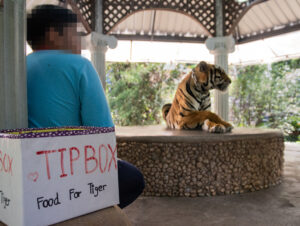
Estimated reading time: 1 minute
Planning a holiday involves various considerations, one of which is ensuring our travel choices are ethical and animal-friendly.
In recent years, the appeal of ethical holidays has grown significantly as travelers become more conscious of their environmental and social footprints.
This guide provides practical advice on how to plan your travel ensuring it aligns with animal-friendly practices.
From selecting the right destinations to understanding the principles of responsible travel, discover how to make your holiday enjoyable and ethical.
Ethical holidays
Make your next holiday is an ethical adventure by only seeing animals in their natural habitat or at legitimate wildlife sanctuaries.
That’s the message animal welfare organisations want all prospective tourists to hear.
World Animal Protection Australia explain what ethical holidays are and how best to prepare and plan for a holiday.
The cruelty behind the wildlife entertainment industry
“Wildlife cruelty should not be on anyone’s itinerary,” Suzanne Milthorpe, World Animal Protection Australia.
Wild animals are continuing to suffer globally in the name of tourism.
Performing dolphins, elephant rides, substandard zoos, selfies with tigers.
These are just a few examples of animals being exploited for tourism.
Few travelers know how much animals trapped in the wildlife entertainment industry suffer.
“The wild animals we often see in captive wildlife venues in Australia and around the world, end up there typically through wild-capture or captive breeding,” says Suzanne Milthorpe, Head of Campaigns at World Animal Protection.
Sadly, many of the animals that tourists think are great for social media photos, spend a lifetime of misery behind the scenes.
“The animals are taken from their wild homes and beaten into submission,” says Suzanne.
“They are deprived of food and water or trapped in concrete cages their entire lives.”

Although tourists love animal destinations, Suzanne explains, the animals shouldn’t suffer for their entertainment.
“Wildlife cruelty should not be on anyone’s itinerary,” she implores.
“So, if you can ride or touch an animal, take a photo with them, or see them perform tricks, avoid that venue.”

What to avoid when planning an ethical holiday; examples of wildlife tourism cruelty
Elephant rides Popular in many Asian countries, tourists are offered the change to ride an elephant by sitting in a chair or basket on their back.
But as a matter of fact, the elephants are often subjected to a life (often a very long life) of misery and abuse.
Elephants are often beaten into submission and continue to be subjected to physical abuse throughout their life to make them docile and easier to control.
Swimming with dolphins In captivity, dolphins are kept in small tanks and are forced to perform tricks for the entertainment of tourists.
Dolphins are extremely intelligent, social animals that need space and freedom to move and interact with others.
Dolphin shows deny them of the most basic right of their freedom.
Selfies with tigers In some countries, tourists can pat tiger cubs and take selfies with grown tigers.
The cubs are often taken from their mother after they are killed and drugged continuously to keep them docile.
Often, the tigers endure physical abuse.
Bullfighting It’s hard to believe a practice (so-called sport) so barbaric is still legal, let alone so popular.
Basically, there’s not much that needs to be said about bullfighting; it can simply be described as the torture and killing of bulls in front of an arena packed with cheering spectators.
What are ethical holidays and animal-friendly travel?
Ethical holidays, or responsible travel, means people are mindful of the impact their holiday has on animals and the environment.
Many travelers don’t realise the cruelty behind many of the wildlife attractions, so proper research is a must before heading off on a trip.
“Animal-friendly tourism simply means observing animals in their natural environment,” says Suzanne.
“As well as only doing activities at places that work hard to protect animals, not exploit them.
“The best wildlife experiences are wildlife-friendly ones.
“This means only seeing koalas, dolphins, sea turtles, elephants, and tigers in their natural ocean or forest homes.

“Where they can exhibit natural behaviours, are not in harm or spending a lifetime in misery just so tourists can take a photo.
“It’s travelling with a reputable company who works hard to protect animals.
“It’s this kind of organisation and tour operator you should support, by traveling with them, by making donations, by suggesting them as good companies to other travelers.”
Planning for an ethical holiday? Here’s World Animal Protection Australia’s top picks:
- Sri Lanka
See wild elephants roaming the wild which has the highest density of wild Asian elephants in the world.
Above all, the best places to experience are Uda Walawe, Wilpattu or Minneriya National Parks.
- India
See tigers in their natural habitat in Ranthambore National Park in India, part of a national conservation initiative.
We’ve previously written about India’s spiritual love of cows, and it’s amazing to observe the respect they have for them.
- Great Barrier Reef
You can spot six of the world’s seven species of sea turtle on the Great
Barrier Reef in Australia– including green turtles off Green Island.
- Magnetic Island
Located within the Great Barrier Reef, Magnetic Island is the home of one of Australia’s largest koala populations.
The island has open eucalypt woodland of bloodwoods, stringybarks and grey ironbarks covering it.
The best part is the koalas aren’t too difficult to spot since most of the eucalyptus trees are quite low.
Hot tip – one of the best ways to spot koalas nearby is to look for their olive-like poo!
- Hervey Bay
Hervey Bay is the world’s first Whale Heritage Site because it highlights responsible whale and dolphin watching adventures.
It’s the whale-watching capital of Australia, so you are sure to spot dolphins happily exploring their ocean home here.
Hervey Bay is a wonderful place for children and families to see dolphins just being dolphins in their natural habitat.
Read more about the history of World Animal Protection.













It’s a very disturbing trend and it feels like the biggest social media companies are not doing enough to combat these types of videos. I just found a channel in YouTube that shows countless videos of a masked nan rescuing a monkey from wire and fallen branches. The same animal appears over and over again. They even show them burying a deceased monkey with a fake sad ceremony. It’s very disturbing and yet YouTube does not have an “animal abuse” category under their list if reasons for reporting a video.
HI howard, yes we agree, it is incredibly disturbing. In 2021, YouTube said they would put processes and policies in place to stop these videos, yet it appears that nothing still has been done. I guess all we can do is make sure we don’t watch, like or share, and educate others, too. Animal Friendly Life team